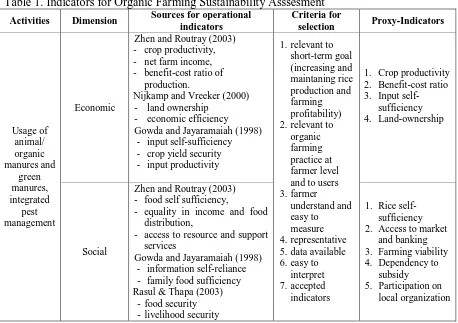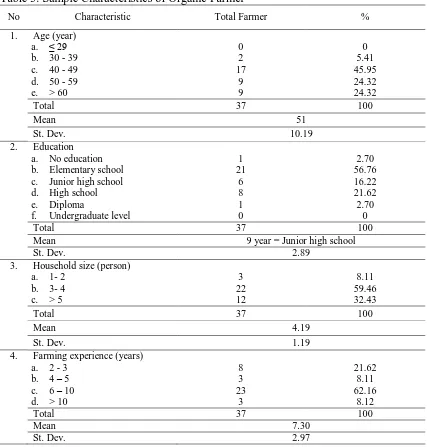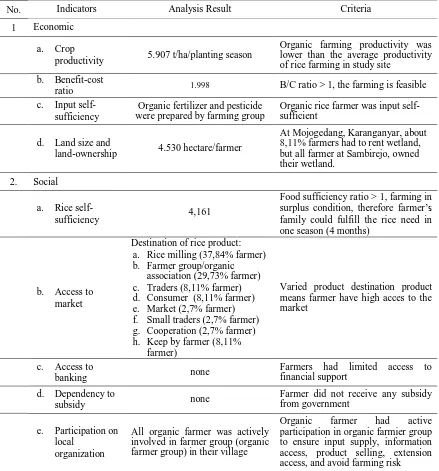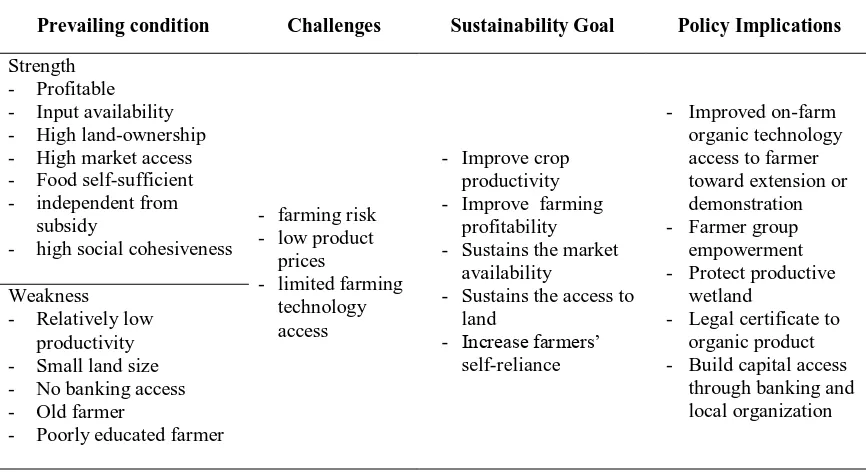SOCIO-ECONOMIC AND ENVIRONEMANTAL DIMENSIONS OF ORGANIC RICE FARMING SUSTAINABILITY
Tinjung Mary Prihtanti
Agribusiness Department, Faculty of Agriculture and Bussines, Satya Wacana Christian University
Jl. Diponegoro 52-60 Salatiga [email protected]
Abstract
Agricultural development strategies that have focused on a goal of high economic growth have shown to cause degradation of production capacity and the quality of the environment. Therefore organic farming development efforts need to be supported in order to remain sustainable. This study proposed operational socio-economics and environmental indicators for measuring rice farming sustainability, which are crop productivity, benefit-cost ratio, input self-sufficiency, land size and land-ownership; rice self-sufficiency, access to market, access to banking, dependency on subsidy, and participation on local organization.
The analysis of sustainability of 37 farm unit surveyed in the Pereng village, Mojogedang, Karanganyar, and Sukorejo village, Sambirejo, Sragen, showed organic rice farming was profitable, input self-sufficient, rice self-sufficient, high market access, independent from subsidy, high farmer’s participation in farmer group; but farming showed low productivity, small land size, high land-ownership, and absence of banking access. Based upon the strength and weakness analysis of sustainability indicators, it is reccomended to improve organic on-farm technology, to enhance farmer group empowerment, to protect the productive wetland, to encourage legal certification of organic product, and to open the capital access through banking or local organization. Keywords: organic rice farming, economic dimension of sustainability, social
dimension of sustainability, sustainability indicators
1. INTRODUCTION
actors. Diagnosing essential dimensions of sustainable farming would likely be a starting point to develop the formulation of sustainable agriculture strategy.
Sustainability in agriculture is a complex concept and nonetheless various parameters for measuring agricultural sustainability have been proposed. The important question: "What should be sustained?". Reijntjes et al. (1992) identified a set of criteria under ecological, economic and social aspects of agricultural sustainability. According to Dalal et al (1999), sustainability in the context of farming systems can be examined through economic viability, sustainable use of resources, improved livelihoods of the local people and protection of ecosystems which are influenced by agricultural activities.
Although large numbers of indicators have been developed by scientists and researchers to assess agricultural sustainability, scientists do not fully integrate ecological, economic, social and institutional aspects. According to Ikerd (1993), the precise measurement of sustainability is impossible as it is a site-specific and a dynamic concept. It is a difficult concept to define, implement, and monitor/measure, especially the ecological indicators.
For organic rice farming, the question thus arises as to how to measure sustainability in this particular context. What are the possible indicators to measure the sustainability of organic rice farming? In Indonesia, the number of organic rice farmer is still limited. At Mojogedang, Karanganyar district and Sambirejo, Sragen district, there were farmer who have been doing organic rice farming continuosly for the last 8 years. In each area, there was an organic farming group that played important role in the development of organic farming. Farming in Indonesia, generally has low incomes which are forcing farmers to cultivate land for economic needs in the short-run, thus sacrifice long term ecological sustainability. Agriculture becomes sustainable only when farmers have reason to make it so.
2. FRAMEWORK FOR ASSESSING THE SUSTAINABILITY OF ORGANIC RICE FARMING
Sustainability indicators should be location-specific and considered within the context of the contemporary socio-economic situation (Dumanski & Pieri, 1996; Rasul & Thapa, 2003). Most of the indicators, however, cannot be used to assess sustainability at the farm level, although individual farmers take the major decision in land-use including mode of use and choice of technology (Webster, 1999). Hayati et al (2010) define, measuring sustainability at the farm level is the most precise method. The indicators assessment should analytical soundness and measurability; really measures what it is supposed to detect; measures significant aspect; problem specific; can be reproduced and repeated over time, and have to be specified in terms of quantity, quality and time horizon.
Management of natural resources is the key point of a better production. In the context of organic farming systems within this study, economic and social aspects were considered in the assessment of sustainability of the organic farming. The ecological components such as the usage of organic fertilizer, green manures, as well as organic pesticide, and herbicides, were the causes of the social-economic components. Assessment of variables such as food security, risk and uncertainties is highly relevant for agriculture sustainability and livelihood security in rural areas (Pretty, 1995; Rasul & Thapa, 2003). Therefore, social indicators in this study included aspects of food security, input self-sufficiency, and participation in local organizations.
This study short-term goals are increasing rice production and reducing poverty.
Indicator’s goal setting is an important part of its planning and development by ensuring that participants have a clear understanding on what they do to obtain or assist to obtain an essential set of indicators.
Table 1. Indicators for Organic Farming Sustainability Asssesment
Activities Dimension Sources for operational indicators
Criteria for
selection Proxy-Indicators
Usage of animal/ organic manures and green manures, integrated pest management Economic
Zhen and Routray (2003) - crop productivity,
- net farm income,
- benefit-cost ratio of production.
Nijkamp and Vreeker (2000)
- land ownership
- economic efficiency
Gowda and Jayaramaiah (1998) - input self-sufficiency - crop yield security - input productivity
1.relevant to short-term goal (increasing and maintaning rice production and farming profitability) 2.relevant to
organic farming practice at farmer level and to users 3.farmer
understand and easy to measure 4. representative 5.data available 6.easy to
interpret 7.accepted indicators
1. Crop productivity
2. Benefit-cost ratio 3. Input
self-sufficiency
4. Land-ownership
Social
Zhen and Routray (2003) - food self sufficiency,
- equality in income and food distribution,
- access to resource and support
services
Gowda and Jayaramaiah (1998) - information self-reliance - family food sufficiency Rasul & Thapa (2003)
- food security - livelihood security
1. Rice self-sufficiency
2. Access to market
and banking 3. Farming viability
4. Dependency to
subsidy 5. Participation on
local organization
3. RESEARCH DESIGN AND METHOD
Study Area
This study focused on wetland rice farming at Pereng village, Mojogedang, Karanganyar district and Sukorejo village Sambirejo, Sragen district.. Sample districts as study area were chosen for two reasons. Firstly, they are typical of intensive rice-growing areas in Central Java Province. Secondly, the two area were consistently expanding the organic rice cultivation until now, 3 times in a year.
Survey and measurements
Statistical Analysis
This study adopted 4 operational economics indicators and 5 operational social indicators of farming sustainability at farm level (Table 2). Statistical tests such as mean comparison and percentage were applied in this study.
Table 2. Sustainable Organic Farming Indicators Measurement
No Proxy-Indicators Measurement
Economic dimensions
1. Crop productivity
Productivity value is calculated using the following equations: P = yield/farm size
Where P is the yield of dry grain produced per season rice farming, measured in ton per hectare.
Critria: if the productivity is higher than the average productivity of rice farming in the study site, the farming is feasible to do.
2. Benefit-cost ratio
B/C ratio simply compares value of benefit to costs
Criteria: if the B/C ratio is greater than 1, the benefit is greater then costs, and the farming meets the criterion for profitability
3. Input self-sufficiency
Through interview method, the rice farming input supply which includes the supply of seeds, organic fertilizers, and organic pesticides was analyzed. If farmer is able to supply the farming input by himself, the farmer has the potential to be independent and to sustain the farming.
4. Land-ownership
Sustainable land, implies the provision of land to support economic needs. Access to land with rent system was risky to healthy land and conversion.
Social Dimension
5. Rice self-sufficiency
Rice self-sufficiency is calculated by dividing the value of rice-equivalent farm production by rice consumption within one growing season. Rice Sufficiency Ratio (RSR) = 1 indicates adequate rice supply, RSR > 1 means farm household achieved rice surplus, and RSR <1 indicates defficiency of rice supply (Sadikin and Subagyono, 2008)
6. Access to market
Market access is measured through the identification of a sale of farm descriptively. The more varied points of sale of the destination, the more potential towards sustainable farming
7. Access to banking
Access to bank indicates the potential of organic rice farmers to gain capital, more and the more farmers transact with the bank, the more potential access to capital is.
8. Dependency on subsidy
The dependency on government subsidy may indicate low potential for sustainability of farming
9. Participation in local organization
4. RESULTS AND DISCUSSION
Organic Rice Farmer’s Characteristics
Table 3 describes the studied farmer’s characteristics. As shown in Table 3, the organic rice farmers are relatively old, poorly educated, and relatively have low burden of family responsibilities. Organic rice farming experience for 7 years is long enough to improve soil health and the environment.
Table 3. Sample Characteristics of Organic Farmer
No Characteristic Total Farmer %
1. Age (year)
a. ≤ 29 0 0
b. 30 - 39 2 5.41
c. 40 - 49 17 45.95
d. 50 - 59 9 24.32
e. > 60 9 24.32
Total 37 100
Mean 51
St. Dev. 10.19
2. Education
a. No education 1 2.70
b. Elementary school 21 56.76
c. Junior high school 6 16.22
d. High school 8 21.62
e. Diploma 1 2.70
f. Undergraduate level 0 0
Total 37 100
Mean 9 year = Junior high school
St. Dev. 2.89
3. Household size (person)
a. 1- 2 3 8.11
b. 3- 4 22 59.46
c. > 5 12 32.43
Total 37 100
Mean 4.19
St. Dev. 1.19
4. Farming experience (years)
a. 2 - 3 8 21.62
b. 4 – 5 3 8.11
c. 6 – 10 23 62.16
d. > 10 3 8.12
Total 37 100
Mean 7.30
St. Dev. 2.97
was enough to heal the soil from agrochemicals, but many changes being observed in the environment were long term, occurring slowly over time. Organic agriculture considers the medium- and long-term effects of agricultural interventions on the agro-ecosystem.
Economics and Social Sustainability Potential
Analysis of operational indicators of sustainability of organic rice farming at the farm level can be seen in Table 4.
Table 4. Sustainability Indicators of Organic Farming
No. Indicators Analysis Result Criteria
1 Economic
a. Crop
productivity 5.907 t/ha/planting season
Organic farming productivity was lower than the average productivity of rice farming in study site
b. Benefit-cost
ratio 1.998 B/C ratio > 1, the farming is feasible
c. Input
self-sufficiency
Organic fertilizer and pesticide were prepared by farming group
Organic rice farmer was input self-sufficient
d. Land size and
land-ownership 4.530 hectare/farmer
At Mojogedang, Karanganyar, about 8,11% farmers had to rent wetland, but all farmer at Sambirejo, owned their wetland.
2. Social
a. Rice
self-sufficiency 4,161
Food sufficiency ratio > 1, farming in surplus condition, therefore farmer’s family could fulfill the rice need in one season (4 months)
b. Access to
market
Destination of rice product:
a. Rice milling (37,84% farmer)
b. Farmer group/organic
association (29,73% farmer)
c. Traders (8,11% farmer)
d. Consumer (8,11% farmer)
e. Market (2,7% farmer)
f. Small traders (2,7% farmer)
g. Cooperation (2,7% farmer)
h. Keep by farmer (8,11%
farmer)
Varied product destination product means farmer have high acces to the market
c. Access to
banking none
Farmers had limited access to financial support
d. Dependency to
subsidy none
Farmer did not receive any subsidy from government
e. Participation on
local organization
All organic farmer was actively involved in farmer group (organic farmer group) in their village
Organic farmer had active
Analysis result showed the potential of economic and social dimensions of organic rice farming sustainability. Productivity of organic rice farming was not showing sustainability because it is below the average value of rice productivity in the region which is about 7 to 8 tons/ha. Land size and land ownership are also less sustainable for a relatively narrow size that is below 0.5 ha and it was found that 8.11% organic rice farmers have to rent the land. Profitability is a fundamental indicator of an economically viable farm, and the organic rice farming is profitable, as shown the B/C ratio > 1. This study finding is consistent with the result of Rubinos et al (2007) that cash cost in organic farming is lower so that its return above cash cost is significantly higher.
On the other side, social dimension is a vital part of sustainable paradigm. The analysis showed that organic farming ensured food-self sufficiency, means one planting season can fulfill household consumption need of rice for 4 months. Variability in market access showed potential to farming sustainability, and it can estimate that there will be growing numbers of organic rice consumers. Novianty and Andoyo (2006 at Syarip and Lesmana, 2011) mentioned that the potential market for organic products in Indonesia is around 37 percent of the population, a group that comprises mainly middle and uppermiddle class people who mainly live in the cities. Unfortunately, organic rice farming has no access to banking or capital facilitation, as Syarip and Lesmana (2011) defined there are problems for paddy farming that come from inadequate farming skills and lack of capital resources. Organic rice farming do not receive subsidy from government or other institution, thus it indicates that organic rice farmers have been self-sufficient in the provision of farm inputs. Farming inputs, i.e. fertilizers and organic pesticides, were processed together in farmer groups, and it tends to encourage unity among organic rice farmers. Pretty (2009 in Roy et al. 2013) defined sustainable
agriculture, in fact, is a “social learning” approach rather than a precise set of
Strength-Weakness Analysis for Management of Social-Economic Potentials to The Development of Organic Farming Sustainability
The development of policy implications for practical application on organic farming represents the last step for adapting analysis outcome of social-economics sustainability assessments into implementation of organic agricultural practice. These policy implication support farmer, government, and other end-users, to improve the sustainability of the existing systems.
.
Table 5. Policy Implication to Development Organic Farming Sustainability
Prevailing condition Challenges Sustainability Goal Policy Implications
Strength
- Profitable
- Input availability
- High land-ownership
- High market access
- Food self-sufficient
- independent from
subsidy
- high social cohesiveness
- farming risk
- low product
prices
- limited farming
technology access
- Improve crop
productivity
- Improve farming
profitability
- Sustains the market
availability
- Sustains the access to land
- Increase farmers’ self-reliance
- Improved on-farm
organic technology access to farmer toward extension or demonstration
- Farmer group
empowerment - Protect productive
wetland
- Legal certificate to organic product - Build capital access
through banking and local organization Weakness
- Relatively low
productivity
- Small land size
- No banking access
- Old farmer
- Poorly educated farmer
The main challenges to developing organic farming is the lack of government’s attention and support, therefore in the future it will be important that the government provides better support in form of the establishment of specific organic technologies, subsidies, inspections, and certification.
CONCLUSIONS
The analysis of the sustainability of farms surveyed in the Pereng village, Mojogedang, Karanganyar, and Sukorejo village, Sambirejo, Sragen, showed that organic rice was cultivated in the relatively small-size wetland; in average 4.530 m2/farmer, and about 8.11% farmers had to rent the land. The average organic rice productivity was also relatively low, 5.907 tonnes/hectare. However organic rice farms were profitable as indicated by the value of B/C ratio which reached 1.998. It is also important to note that organic rice farmers prepared their own fertilizer and pesticide in farming group, which can be translated into lower inputs costs and higher self-sufficiency.
Social indicators of organic rice farming analysis showed that most studied households were in surplus rice supply with various market destination for the sale. Farmers were mostly independent from government subsidy and actively involved in organic farmers group. However farmers were still encountering contraints in accessing financial support from banking or other financial institutions.
A set recommendations based upon the strength and weakness of sustainability indicators analysis, i.e. improved organic on-farm technology access, farmer group empowerment, protection of productive wetland, legal certification of organic product, capital access through banking and local organization.
REFERENCE
Dunn, Jerry W. and Jeffery R. Williams. 2000. Farm Characteristics that Influence Net Farm Income Variability and Losses. Paper presented at the Western Agricultural Association Annual Meetings, Vancouver, British Columbia, June 29-July 1 2000. Ageconsearch.umn.edu/bitstream/36337/1/sp00du01.pdf. retrieved on 6/11/2014.
Ikerd J. 1993. Two related but distinctly different concepts: organic farming and sustainable agriculture. Small Farm Today 10(1):30–31
Novianty, Diana and Roby Andoyo. (2006). Organic Market in Indonesia. Unpublished paper.
Pretty, J., 2009. Can ecological agriculture feed nine billion people? Monthly Review, November.
Roy, Ranjan, Ngai Weng Chan, Ruslan Rainis. 2013. Development of Indicators for Sustainable Rice Farming in Bangladesh: A Case Study with Participative Multi-Stakeholder Involvement. World Applied Sciences Journal 22 (5):672-682.
Rubinos, Ronajoy, Ana Theresa Jalipa, and Purisima Bayacag. 2007. Comparative Economic Study of Organic and Conventional Rice Farming in Magsaysay, davao Del Sur. 10th National Convention on Statistics (NCS) October 1-2 2007.
Sadikin, Ikin, and Kasdi Subagyono. 2008. Welfare Indicators Performance of Rice Farmer at Kara wang Rural 2008.
Syarip, Agus, and Teddy Lesmana. 2011. The Development of Organic Rice Farming in Indonesia. RIEBS Vol 2 No. 1, June 2011.



